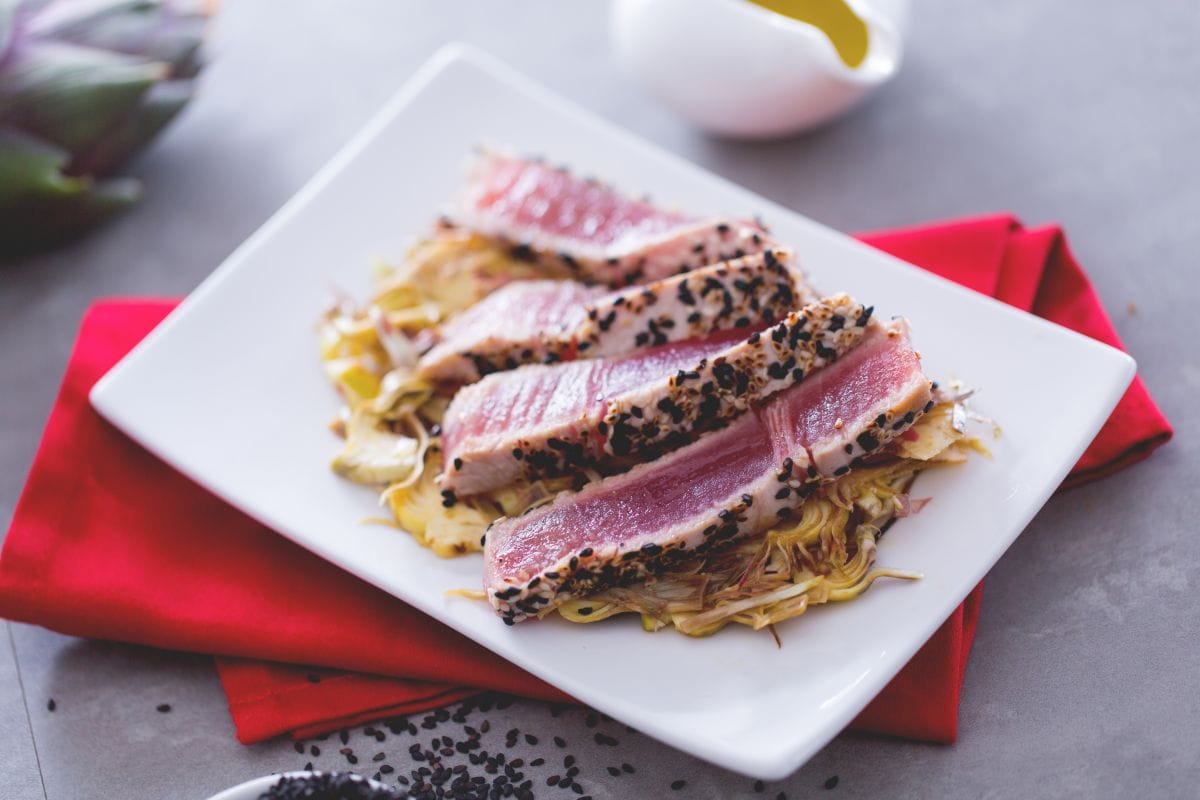Tuna and salmon skewers with Thai salad
- Easy
- 40 min
- Kcal 274

Sesame crusted tuna is a fun blend of Japanese flair and a hint of Western twist—perfect for when you want something simple yet stylish. With just a quick sear, the outside gets this crisp bite, while the inside stays tender and beautifully pink. Seriously good. It’s like your classic seared tuna recipe but with that "black and white" sesame seed magic. It’s not just for show; it adds a nutty flavor that pairs with the fish’s clean taste. And the sauce? A drizzle of citronette gives it a tangy hit—making each bite fresh and special. Traditionally, it’s over a crunchy bed of raw artichokes in season, but honestly, any diced seasonal veggies will do.
Thing is, by sticking to the basics and adding just a few smart extras, the tuna steak recipe really shines. In winter, maybe switch it up—ratatouille or a tataki-style finish with anchovy. Which is great. Some folks roll the fish in chopped nuts or pistachios instead of just sesame, adding crunch and color. Pretty much. This gives the dish a relaxed yet classy vibe, and it's easy to see why sesame seared tuna has fans worldwide.
You gotta use sushi-grade tuna to keep it moist and let its fresh, almost sweet flavor pop. For real. A quick dip in soy sauce before searing can add depth, but honestly, the real magic is how the sesame crusted tuna lets the fish do the talking. Serve it as an appetizer at a dinner party or as the star of a sesame tuna salad—can’t go wrong. The combination of crunchy crust and soft center makes for a dish that looks sharp and tastes even better. The fusion of Japanese tradition with Western influences creates something not only satisfying for the palate but visually appealing too, making it a go-to for any dining occasion.
You might also like:

To prepare the sesame tuna, start by cleaning the artichokes. Before handling the artichokes, we recommend rubbing your hands with lemon to avoid the substances inside this vegetable, which oxidize when in contact with air, from blackening your hands. Alternatively, you can use gloves. Prepare a bowl with cold water and squeeze the juice of a lemon inside: the acidic solution will prevent the cleaned artichokes from blackening. Cut the stem part with a knife, leaving a couple of inches from the leaves 1, remove the outer leaves keeping only the tender heart 2, and cut off the tip of the leaves that have spines 3.

With a paring knife, remove the most superficial layer of the remaining stem, which is the most fibrous part 4, split the artichokes in half and remove the inner choke 5, as you clean the artichokes, soak them in the acidulated water you've prepared with the lemon juice 6.

Now prepare the citronette. Squeeze the lemon juice 7 and strain it through a sieve 8, add the olive oil in a thin stream and whisk the citronette 9.

Salt and pepper 10 and set aside. Now julienne the artichokes 11, gather them in a bowl and season them with half of the citronette 12, the remaining part will be used to season the tuna.

In a plate, pour the white sesame seeds and black sesame seeds 13, mix them 14. Take the tuna: we recommend ensuring the tuna you purchased has been frozen; we also advise freezing it for at least 96 hours at -0.4 degrees Fahrenheit, then thawing it before using it in the recipe. Pass the tuna slices over the seeds to coat them on both sides 15.

as uniformly as possible 16. Heat a non-stick pan and only when it is very hot, place the breaded tuna fillets 17 and cook over high heat for 1 minute, then turn them with a spatula 18, continue cooking for another minute. Cooked this way, the tuna will be raw inside but if you like, you can prolong the cooking time according to your taste.

Once cooked 19, transfer the fillets to a cutting board, immediately slice them 20, and serve them immediately, garnishing the sesame tuna with the remaining citronette and accompanying it with the artichoke salad 21.